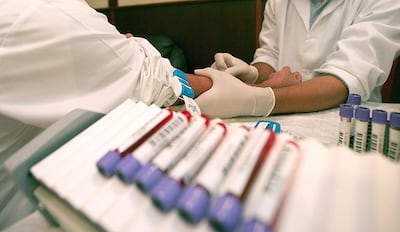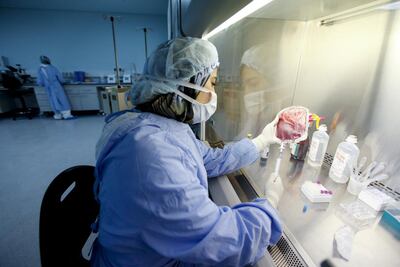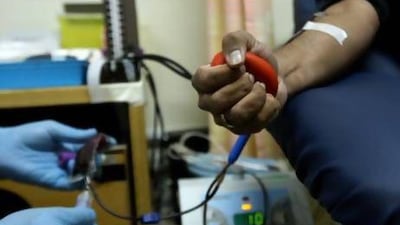When Roanna Maharaj was diagnosed as a baby with the blood disorder thalassaemia, the prognosis doctors gave her parents was like “a death sentence”, she said.
Born in the Caribbean nation of Trinidad and Tobago, Ms Maharaj had a poor outlook because the specialist care needed was not easily available. Many people with thalassaemia died in their teens – if diagnosed. Otherwise, they did not live beyond infancy.
Now 31 and living in the UK, Ms Maharaj, a PhD student, keeps her condition stable at the cost of considerable restrictions on her lifestyle.
She undergoes lengthy infusions of medication at home and regular blood transfusions in hospital, in addition to taking multiple oral medications.
“It’s quite a full-time job trying to manage a chronic illness,” she said. “It’s quite life-limiting – it impairs your quality of life.”
But now the day when some people with thalassaemia will be able to say goodbye to such interventions is moving closer thanks to gene-based treatments.
“My parents said they heard about gene therapy 20 years ago,” said Ms Maharaj, a trustee of the UK Thalassaemia Society.
“It’s something that potentially could cure thalassaemia. It’s innovative and it couldn’t come at a better time.”

Thalassaemia is caused by the body failing to produce enough haemoglobin, the iron-containing blood protein that carries oxygen.
The condition is common in people of Middle East descent, and about 8.5 per cent of UAE citizens are thought to carry the defective gene.
Some forms involve less (β+) or no (β0) production of the beta subunit of haemoglobin, and Ms Maharaj has a particularly severe form, β0β0.
Like another blood condition, sickle-cell disease, in which red blood cells are misshapen, it is caused by a single gene mutation and because of this, treatments using gene therapy and gene editing are possible.
Already undergoing trials, these are an alternative to bone marrow transplants, which require a matched donor.
Prof David Rees, a consultant in paediatric haematology at King’s College Hospital, London, who has been working with people with thalassaemia since the 1990s, said developments were “very exciting”.
“It’s nice to see it reach a point where it’s being used for clinical benefits,” he said.
What causes thalassaemia?

The UAE has about 2,000 residents with thalassaemia, about half Emirati, because the mutations causing the condition are relatively common, and consanguineous marriages have traditionally been popular.
In recent years, premarital screening to determine if couples are thalassaemia carriers has helped to cut the numbers of babies born with the condition in the Emirates by half.
Carriers have inherited the mutation from one parent but are healthy because they have the normal form of the gene from the other parent.
A child develops thalassaemia when both parents pass on the mutation.
How do the new treatments for thalassaemia work?
Some of these new treatments for thalassaemia cause the body to start making foetal haemoglobin, production of which normally ceases when a baby is a few months old.
Among them is a gene editing treatment from Swiss-based company, Crispr Therapeutics, which employs technology called Crispr-Cas9 to reduce expression of a protein, BCL11A, which normally suppresses foetal haemoglobin production.
Crisprs, which are particular stretches of DNA, work with the Cas9 enzyme, like a pair of 'molecular scissors', to change a person’s genetic material.
Bone marrow cells extracted from the individual are treated with Crispr-Cas9, which reduces expression of BCL11A
Treated bone marrow cells are reintroduced and the recipient begins producing foetal haemoglobin again, compensating for the absence of or defects in adult haemoglobin.
Dr Samarth Kulkarni, Crispr Therapeutics’ CEO, said the first recipients “were essentially cured” and, when assessed over two years, remained healthy.
“[Those with thalassaemia] required a blood transfusion once or twice a month,” he said. “Now they’re completely transfusion-independent and live normal lives.”
People admitted to hospital with sickle cell disease and treated in the same way have returned home without the chronic pain that blighted their lives.
With these “very positive” results, Crispr Therapeutics hopes to achieve commercialisation within two to three years.
A treatment from another California biotechnology company, Sangamo Therapeutics, is similar but uses gene editing tools called zinc nucleases to target BCL11A.
In trials with small numbers of individuals, it too has achieved good results.
Bluebird Bio, based in Cambridge, Massachusetts employs gene therapy, in which a new gene is added to a person’s genetic material.
In this case, a virus takes a normal copy of a gene that produces a haemoglobin subunit into the stem cells.
Branded Zynteglo, this has been approved in the European Union but, with a $1.8 million (Dh6.8m) price tag, it is not cheap.
Proponents say one-off costs should be balanced against the price of ongoing treatment, which can be hundreds of thousands of dollars a year.
Balancing costs of treatment

High prices are a hurdle to the adoption of these new treatments even in wealthier parts of the world such as the US and Europe, according to Prof Rees, and will be “a huge barrier” in poorer nations such as Pakistan or Bangladesh where thalassaemia rates are high.
Another issue is that chemotherapy is required to destroy patients’ remaining bone marrow stem cells before the genetically altered ones are returned.
Not all people with thalassaemia are well enough to receive this chemotherapy dose, which Crispr Therapeutics concedes is of “high intensity”.
The company hopes to develop “gentler conditioning regimens”.
The risks of some new treatments are hard to justify for individuals whose condition is stable, and who have a good quality of life and normal life expectancy, said Prof Rees.
“It’s not leukaemia, where you know people will die if you don’t treat them,” he said.
“This is a condition that does have an established standard of care that is not great, but it does pretty much work and keep you alive and keep your quality of life up, as long as you have regular blood transfusions.”
Also, while treatments developed so far can make patients transfusion independent, he said targeting foetal haemoglobin, as some treatments do, was being done because it was technically possible rather than the ideal strategy.
It is likely that treatments will improve, with harsher aspects removed, and costs will fall.
Prof Rees said they may ultimately be delivered simply through injection.
“I think in 10 years’ time, gene therapy of one sort or another will be widely available for most people, maybe everyone, with thalassaemia,” he said.
While Ms Maharaj’s very severe form of thalassaemia makes her ineligible for treatments authorised for the UK, she too predicts that in the long run, the new technology will have a positive impact for many.
“It’s really exciting and I think it will be something to change the world if it’s made available,” she said.






